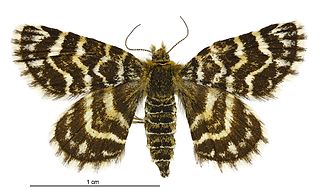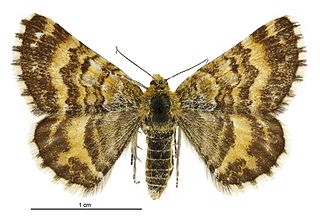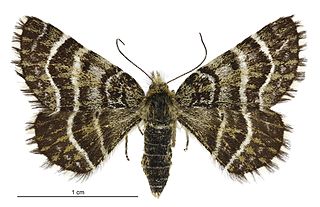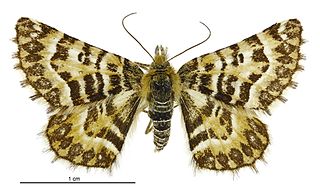
Dasyuris is a genus of moths in the family Geometridae first described by Achille Guenée in 1868.

Ischalis is a genus of moths in the family Geometridae. The genus was erected by Francis Walker in 1863. All species within this genus are endemic to New Zealand.

Parienia is a genus of moths belonging to the subfamily Olethreutinae of the family Tortricidae. This genus was described by Edward Meyrick in 1881. It consists of only one species, Parienia mochlophorana, which is endemic to New Zealand.

Heterocrossa sanctimonea is a moth of the Carposinidae family first described by Charles E. Clarke in 1926. It is endemic to New Zealand.

Pasiphila bilineolata is a moth in the family Geometridae. It is endemic to New Zealand and can be found in the North and South Islands. The species inhabits native forest and shrubland and the larvae feed on Hebe species. Adults are on the wing commonly from August to January but have been observed most months of the year and are attracted to light.

Asaphodes aegrota is a species of moth in the family Geometridae. It was first described by Arthur Gardiner Butler in 1879 as Selidosema aegrota. It is endemic to New Zealand and can be found in the North, South and Stewart Islands. This species inhabits open spaces in lowland native forest. The larvae of A. aegrota feed on native herbs and have also been observed feeding of the introduced lawn daisy. The adults are variable in appearance with the markings on both sides of its wings varying in intensity. Some populations also have narrow winged females. Adults are on the wing from November until March.

Aristotelia paradesma is a moth of the family Gelechiidae. It was described by Edward Meyrick in 1885 and is endemic to New Zealand. This species has been observed on both the North and South Islands. The larvae feed on Coprosma species creating and living in stem galls. The adults are on the wing from November to March and are attracted to light.

Dasyuris partheniata is a species of moth in the family Geometridae. It is endemic to New Zealand. It is classified as "At Risk, Declining" by the Department of Conservation.

Notoreas hexaleuca is a species of moth in the family Geometridae. This species is endemic to New Zealand.

Tingena nycteris is a species of moth in the family Oecophoridae. It is endemic to New Zealand and has been observed in the North and South Islands. This species inhabits native forest and scrubland and adults are on the wing from October to January.

Dasyuris anceps is a species of moth in the family Geometridae. It is endemic to New Zealand.

Dasyuris austrina is a species of moth in the family Geometridae. It is endemic to New Zealand.

Dasyuris callicrena is a species of moth in the family Geometridae. It is endemic to New Zealand.

Dasyuris catadees is a species of moth in the family Geometridae. It is endemic to New Zealand.

Dasyuris hectori is a species of moth in the family Geometridae. It is endemic to New Zealand.

Dasyuris leucobathra is a species of moth in the family Geometridae. It is endemic to New Zealand.

Dasyuris micropolis is a species of moth in the family Geometridae. It is endemic to New Zealand.

Dasyuris pluviata is a species of moth in the family Geometridae. It is endemic to New Zealand.

Dasyuris strategica is a species of moth in the family Geometridae. It is endemic to New Zealand.

Dasyuris transaurea is a species of moth in the family Geometridae. It is endemic to New Zealand.




















